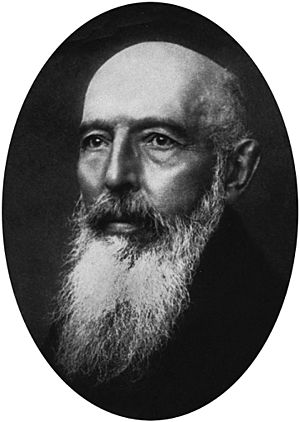Gerhard Armauer Hansen facts for kids
Quick facts for kids
Gerhard Henrik Armauer Hansen
|
|
|---|---|

Gerhard Armauer Hansen
|
|
| Born | 29 July 1841 Bergen, Norway
|
| Died | 12 February 1912 (aged 70) Florø, Norway
|
| Alma mater | University of Oslo |
| Awards | Royal Norwegian Order of St. Olav |
| Scientific career | |
| Fields | Epidemiology |
Gerhard Henrik Armauer Hansen (born July 29, 1841 – died February 12, 1912) was a Norwegian doctor. He is best known for finding the tiny germ, called a bacterium, that causes a disease called leprosy. He made this important discovery in 1873. His amazing work was celebrated at a special meeting about leprosy in Bergen in 1909.
Contents
Hansen's Early Life and Studies
Hansen was born in Bergen, Norway. He went to the Bergen Cathedral School for his education. After finishing school, he worked at a hospital in Christiania (which is now Oslo). He also worked as a doctor in a place called Lofoten.
In 1868, Hansen returned to Bergen. He wanted to study leprosy more closely. He worked at Lungegård Hospital with Daniel Cornelius Danielssen, who was a famous expert on leprosy.
Discovering the Cause of Leprosy
At that time, many people thought leprosy was a disease that ran in families. Some even believed it was caused by bad air. But Hansen studied how leprosy spread among people. He became sure that it was a specific disease with a specific cause, not just something you inherited.
To prove his idea, Hansen traveled to Bonn and Vienna in 1870–71. He wanted to get the training he needed to find the exact cause. In 1873, he announced that he had found a tiny rod-shaped organism in the body tissues of everyone who had leprosy. He used a "new and better" microscope for this discovery.
Working with Albert Neisser
In 1879, Hansen gave some tissue samples to another scientist named Albert Neisser. Neisser was able to color the bacteria so they could be seen more clearly. In 1880, Neisser announced his findings. He claimed that he had discovered the organism that caused the disease.
There was some disagreement between Hansen and Neisser. Hansen had found the germ first, but Neisser had identified it more clearly as the cause of the disease. Neisser tried to make it seem like Hansen's help wasn't very important. Hansen's claim was also made weaker because he couldn't grow the bacteria by itself in a lab. He also couldn't prove that these rod-shaped germs were definitely what caused the infection.
Hansen also faced a problem when he tried to test his ideas on a person without their permission. Even though no harm was done, this led to a court case. Hansen ended up losing his job at the hospital because of this.
Fighting Leprosy in Norway
Even after losing his hospital job, Hansen continued to work as a medical officer for leprosy in Norway. Thanks to his hard work, new laws about leprosy were passed in 1877 and 1885. These laws helped a lot in controlling the disease.
Because of his efforts, the number of known leprosy cases in Norway went down a lot. In 1875, there were about 1,800 cases. By 1901, this number had dropped to just 575 cases. This showed how important his work was in fighting the disease.
Supporting Women's Rights
Gerhard Armauer Hansen was also interested in women's rights. He helped start and was a board member of the Bergen part of the Norwegian Association for Women's Rights. His sister, Amalie Hansen, was a well-known supporter of women's rights and led this group.
Honors and Legacy
Hansen's important work has been remembered in many ways:
- The Leprosy Museum (Lepramuseet) at St. Jørgen Hospital in Bergen is dedicated to him.
- Haukeland University Hospital has a research building called Armauer Hansens hus. It is used by the University of Bergen.
- In Jerusalem, an old leprosy hospital from the 1800s has been named Hansen's name since 1950. It has been turned into an art center, but it still keeps his name.
- The Armauer Hansen Research Institute (AHRI) in Addis Ababa, Ethiopia, is named after him. It is a biomedical research institute that studies diseases like tuberculosis, HIV, malaria, and leishmaniasis.
See also
 In Spanish: Gerhard Armauer Hansen para niños
In Spanish: Gerhard Armauer Hansen para niños


